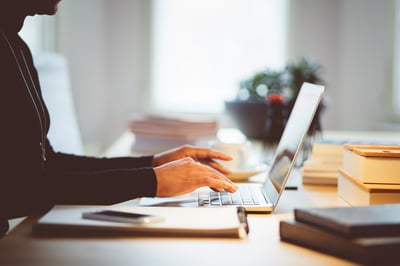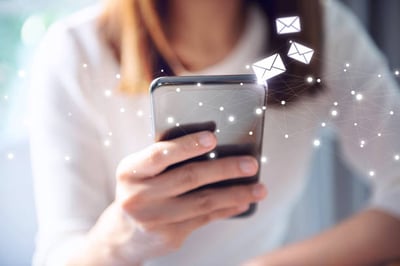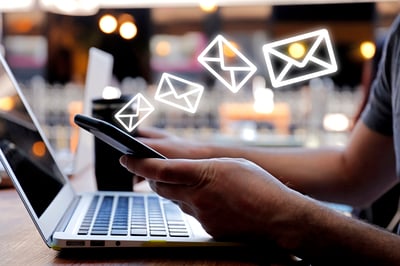February 7, 2025
 by Wendy Wang / February 7, 2025
by Wendy Wang / February 7, 2025

After a successful discussion, what are your post-meeting habits? Do you run off to handle the next tasks, or are you among the few that consolidate your discussion points and set the momentum for the next action?
Most people don’t realize that a meeting is just the starting point of an interaction – how you follow up is what really yields results. A follow-up email after a meeting ensures everyone is aligned and drives actionable outcomes.
After consulting several business executives, I compiled some insights on how to write an after-meeting email that re-engages your audience and helps you meet your goals. Additionally, I've included 10 ready-to-use follow-up email templates you can adapt to get started. Whether you write emails manually or use email automation tools, these templates will help you get responses in no time.
You might be wondering why it’s important to follow up after a meeting that everyone attended. Let’s get into why the simple act of a follow-up email can have a significant impact.
An optimum time to send a follow-up meeting email is between 24 hours and three business days after the meeting ends. The timing can differ depending on the type of meeting, its complexity, and the reason for the meeting. Here are some common scenarios and the timing top business executives agree on.
Remember, the more important the meeting, the sooner you should send a follow-up.
Now that you understand why and when to send a follow-up email after an in-person, online, or hybrid meeting, here is everything you need to know about how to write it.
The subject line is the first text an email recipient interacts with after opening their mailbox. It must be very clear and concise and communicate your message intent. To grab the recipient's attention, avoid using generic phrases like "Meeting Follow-up."
Instead, use action-driving language like:
Start your email with a warm greeting. Thank all recipients for taking time in their busy schedules to attend the meeting and contribute to the discussion. Go that extra mile to specify what you are thankful for, but be brief. For example:
"Thank you [Client Name] for the detailed breakdown into your customer profile -that was very insightful data that will play a significant role in our [Project Goal.]"
As we did, always link what you are grateful for to the next steps. Limit this section to one or two sentences maximum. If you have too many things to thank them for, choose the most significant one and limit the rest for your next in-person meeting.
Your email body should provide a quick recap of all the main topics from the meeting. It serves as a reminder of your discussion and helps keep everyone on the same page. When writing this section, include:
Distill the points in this section into bullet points and keep it as concise as possible for improved readability.
Outline the steps that follow, attributing all the responsibility and providing clear timelines for every meeting action item. An effective way to structure this is to list each stakeholder's name and assigned task, followed by the due date.
You can then list the dependencies or key resources necessary for completing the task before writing the next one. Here is a format to guide you:
As you write this section, always assign tasks to specific persons, not vague owners. You should also set clear deadlines with particular dates to help prevent any task from falling through the cracks. Once you have all the next steps down, include the date of the next meeting to keep the momentum going.
Emails are the best way to follow up after a meeting because they leave behind a trail of documentation that is searchable, easy to reference, and can permanently store attachments and links. You can, however, complement this method using other tools depending on the specific situation. For example:
You don't have to use all these channels. Choose one depending on your recipient's preference and the appropriate formality level.
Now, let's put what you have learned into practice. Here are some ready-to-use follow-up email templates that you can use in different scenarios.
A thank you follow-up email can help you show appreciation and lay the groundwork for future collaboration.
Subject: Thank you for [reason], [Your Name]
Dear [Name],
I am writing to sincerely thank you for taking the time to [specific interaction] today. Your insights about [specific topic discussed] were particularly valuable.
[Optional: Include one insight from your conversation that resonated with you.]
I look forward to [next steps or future interaction].
Best regards,
[Your name]
A follow-up email after a business meeting is necessary to confirm the points discussed and maintain the meeting's momentum.
Subject: Follow-up and next steps for [Meeting Name]
Hello [Stakeholder's Name],
Thank you for attending yesterday's meeting on [topic]. The key points we raised in the meeting include:
Here are the next steps that we established:
I remember you emphasized the importance of [Key point 2] during the meeting. Since then, I've begun [progress update] to address this.
We need a quick decision by [date] to maintain our timeline:
Would you prefer a brief call this week? I have availability:
Which time better suits your schedule?
Best regards,
[Your name]
After a networking event, you can use this template to maintain an impactful connection with other attendees.
Subject: [Name], that [specific industry challenge] you mentioned - I found a solution
Hello [Recipient's Name],
It was great to meet you at [event name] yesterday. I remember we bonded over [topic], and your insights blew my mind.
After the event, I researched and discovered [valuable insight] that addresses the [challenge] you mentioned.
I would love to discuss this further. Would you like to grab a quick coffee next week to discuss implementation, or can I send over a detailed breakdown of the solution?
Which would be more helpful for you?
Best regards,
[Your name]
[Your LinkedIn profile]
P.S. I've highlighted the key findings relevant to your situation on pages [X-Y] of the attached report.
Here is a follow-up email template you can use after a job interview to show your enthusiasm and interest in the position.
Subject: Thank you for the [Position] interview
Dear [Interviewer's name],
Thank you for meeting with me and interviewing me yesterday for the [position] role. After our conversation, I became more interested in joining [Company name].
I was particularly excited about [specific aspect of the role/company discussed]. My experience in [relevant skill] would allow me to [specific contribution].
Please contact me if you need any additional information to support my application.
Best regards,
[Your name]
[Your contact information]
Here is an example of what you could send after a discussion on how your business could collaborate with another company.
Subject: Partnership next steps: Option A or B for [specific initiative]?
Hi [Name],
Thank you for attending yesterday's discussion about potential collaboration between [your company] and [their company]. Your perspective on [specific point they made] aligns well with our vision for [shared goal/objective].
Since our meeting, I've outlined two potential partnership frameworks based on our meeting:
We can pursue a quick-win collaboration that will help us achieve [specific benefit]. However, this will require us to have [resources needed]. The second option is to pursue a long-term strategic partnership that will give us [specific benefit] by [timeline]. For this, we need to have [specific resources].
Do any of these options align with your vision? If so, how about a technical deep-dive next week to refine the framework through a brief workshop with both teams?
I propose the following next steps:
While awaiting your feedback, I'm already working on:
When would be the best time to have our next discussion? Would Tuesday at 2 pm or Wednesday at 4 pm work better?
Best regards,
[Your name]
After presenting a sales proposal, use this template to create momentum and get your recipients to take action.
Subject: Next steps after our sales proposal meeting
Hello [Name],
I'd like to thank your team for attending our presentation meeting.
As promised, here is a link to the proposal, pricing, and implementation timeline. [link]
By executing this proposal, we can achieve the following: [list out all the benefits].
Here are some proven case studies of the success we have brought to clients with a similar problem. [link to case study]
I'd also be happy to schedule a follow-up call to address any questions.
Let me know your thoughts.
Best regards,
[Your name]
Subject: Addressing [their company]'s requirements - Implementation path ready
Hi [Name],
Thank you for taking the time to evaluate [your company] yesterday. I wanted to address the key points discussed in our meeting:
1. [Main concern/requirement 1]Based on your requirements, here's what implementation would look like:
Timeline:
To move forward, we need to schedule a technical review with your IT team and finalize the contract details. Would you prefer to start with the technical review or contract discussion? I am available this Thursday at 10 am or Friday at 2 pm.
Best regards,
[Your name]
P.S. I've attached our implementation guide for your reference.
One of the reasons your emails may be getting no responses is you may be speaking to the wrong person. Here is a template you can use to ask for the decision-maker.
Subject: Quick question re: [solution/product] decision process
Hi [Name],
Thank you for our previous discussions about [product/service/solution]. Your insights about [specific points they mentioned] have been invaluable in understanding what your company needs.
As we explore the [specific value/solution], I realize this decision might also require input from others on your team. Could you point me to the best person to discuss this with?
I want to ensure that I'm speaking to all the right people.
If helpful, I can:
What would work best for your internal process?
I appreciate your help in coordinating this.
Best regards,
[Your name]
If a client misses a scheduled meeting, you can reconnect with them while showing that you are understanding and professional using this template:
Subject: Rescheduling our [topic] meeting
Hi [Name],
I hope everything is okay. I noticed we missed our scheduled meeting today regarding [topic].
I understand schedules can get hectic. Would you like to reschedule for [suggest 2-3 specific times]?
Looking forward to connecting soon.
Best regards,
[Your name]
You can use a follow-up email to solicit feedback from a recipient about a project deliverable you shared.
Subject: Feedback on [project] deliverable and next steps
Hi [Name],
I am following up on the [project deliverable] I shared on [date]. Have you had a chance to review it?
While awaiting your review of the [project deliverable], I've made progress on:
To maintain our momentum, I suggest either:
Which would you prefer? This timing would allow us to [specific benefit/deadline context].
Best regards,
[Your name]
P.S. I've also identified a potential optimization that could [specific benefit] - I'm happy to discuss it during our review.
There are several basic rules you need to follow as you write a follow-up email:
While these points matter, they are common knowledge, and everyone is doing their best to implement them. The actual game changer that many overlook is the email content. How you write and why is the secret to attaining instant success.
There are three main goals you should strive toward when crafting follow-up emails.
If a recipient is hesitant to reply, you can employ several strategies to get them to respond.
For example, you can break down all of your big requests into smaller ones and convince your recipients to agree.
This psychological tactic works in the same principle as the foot-in-the-door technique. This strategy lowers recipients' guard, allowing them to make decisions without much mental effort.
The goal is to get them to agree only once. Once you make a second request, they will also likely agree. For example, "I just need a quick yes or no answer."
You can capture a recipient's attention and interest if you show them clear value or demonstrate an initiative to move your conversation forward. For example, you can provide an unexpected gift, which will make them more likely to reply.
For example, "As I was planning the next steps, I ran your data and compared it to [Company A] to get a clearer view of the areas we decided to work on. Can we schedule a call tomorrow to go through the report?"
Don't just end your email with a "Please share your thoughts." Introduce specific if-then scenarios that can help your respondents to formulate a reply quickly. For example, "If our [offer] meets your needs, how about an in-person meeting on [date]? If not, I am happy with [option 2]."
A follow-up email after a meeting does more than share meeting notes. It's a way to maintain momentum and gently push for results. For it to be effective, it must be clear, concise, and sent at the right time. With these tips and templates, you’ll be able to develop your own follow-up email writing style.
Want to learn more? Check out how AI will impact email communications and make you more efficient.
Edited by Holly Hunt
Wendy is a content marketer at Notta, an AI meeting assistant that helps record, transcribe, and summarize conversations to actionable text, making meetings delightfully productive. She loves writing about workplace efficiency and technology.
Have you ever given up on a purchase because you didn’t get a response from the brand?
 by Kasia Slonawska
by Kasia Slonawska
Email is an integral part of today’s culture, both at work and at home.
 by Thomas Yuan
by Thomas Yuan
Have you ever given up on a purchase because you didn’t get a response from the brand?
 by Kasia Slonawska
by Kasia Slonawska



